Tracing the Artistic Practice of Delacroix with Devotion to Drawing Curator Ashley Dunn
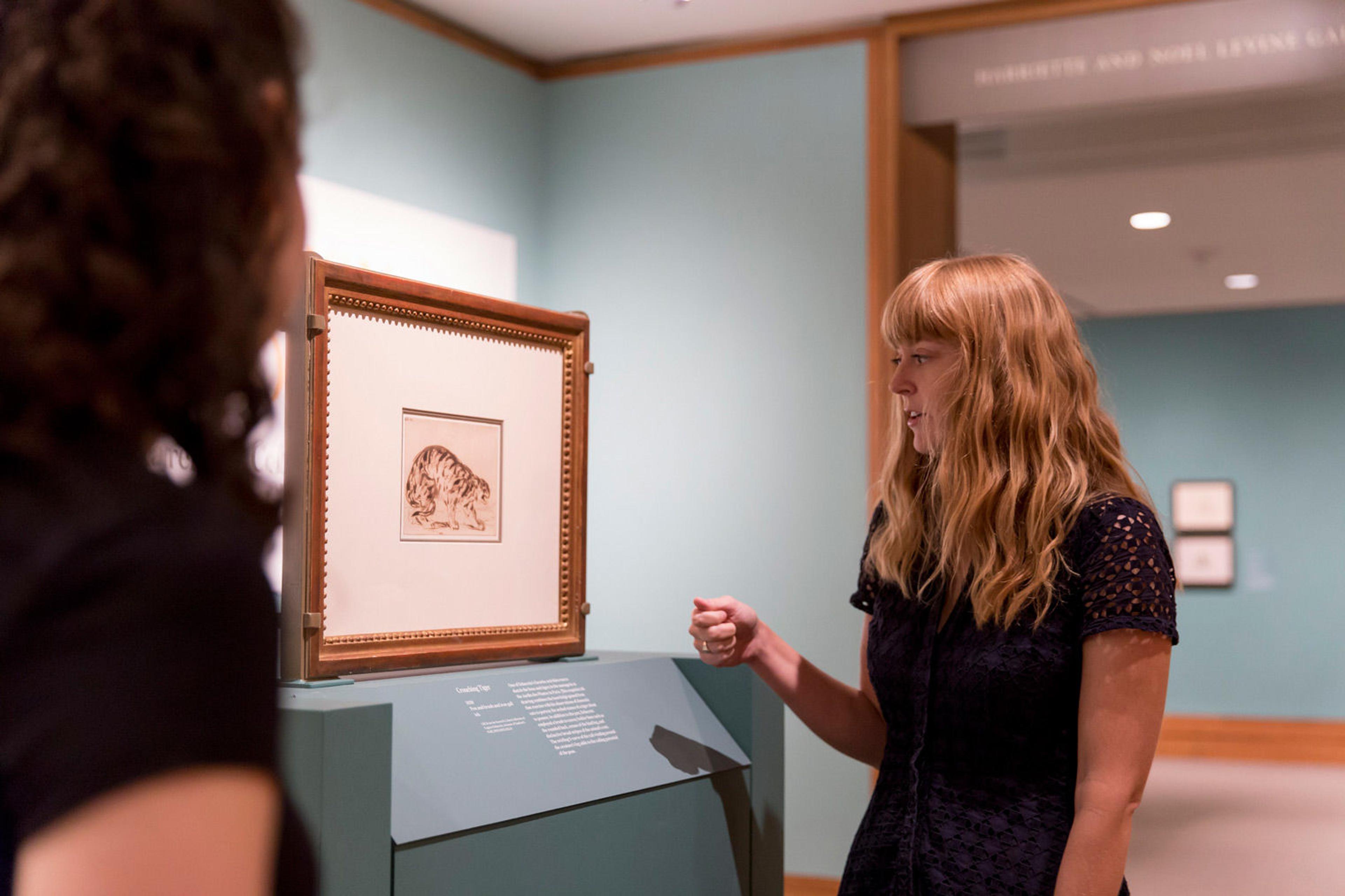
Assistant Curator Ashley Dunn discusses Delacroix's Crouching Tiger during a tour of Devotion to Drawing: The Karen B. Cohen Collection of Eugène Delacroix. Photo by Rebecca Schear
2018 is the year of Eugène Delacroix here at The Met. Not only is there the first comprehensive retrospective of the artist's work in North America, but visitors also have the chance to explore more than one hundred works on paper by Delacroix in the exhibition Devotion to Drawing: The Karen B. Cohen Collection of Eugène Delacroix, which celebrates a major gift to The Met from Karen B. Cohen, an Honorary Trustee and longtime supporter of the Museum. Comprising watercolors, sketchbooks, preparatory drawings, and copies of old master prints, Cohen's renowned collection was assembled with an eye to the artist's process, and highlights the ways in which drawing shaped Delacroix's artistic development throughout his career.
I recently took a walk through the Devotion to Drawing galleries with the exhibition's curator, Ashley Dunn of the Department of Drawings and Prints, to learn more about Delacroix's artistic practice as related to drawing, copying, and illustration, as well as his love of nature and the transformative impact Cohen's gift has had on The Met collection.
Michael Cirigliano: The exhibition showcases a staggering array of ways Delacroix approached drawing, including figural studies, landscapes, illustration, and even caricatures. What was Delacroix looking to achieve through this medium?
Ashley Dunn: What we see through this exhibition is that he used drawing both as a means of investigation, and also as a means of invention. So we see him learning through copying, studying the world around him, and all of that becomes integrated into his practice as a painter. But we also see him using his imagination and, in places, almost doodling to come up with new kinds of form, to really create in the most basic way, on the paper.
Michael Cirigliano: I love that idea of "doodling." There are plenty of examples—sheets of horses and other animals, knights in armor, hands—where it does look exactly like that. It's drawing without any reservation, with complete freedom, rather than just "this is preparation for another type of work."
The Karen B. Cohen Collection, which Devotion to Drawing celebrates, has amplified both the collection of the Department of Drawings and Prints and The Met collection as a whole. What role do you see this collection playing in expanding the narrative The Met can deliver about Delacroix?
Ashley Dunn: Karen B. Cohen has single-handedly transformed The Met's collection of Delacroix, through her gifts over the years and with this recent promised gift. She's a collector with an interest in artistic process. In addition to acquiring drawings of obvious importance because they relate to major projects or are significant works in their own right, she bought drawings that probably many people would have passed over—tracings and copies that perhaps a less curious or informed collector might not have taken an interest in. But they offer so much insight, of course, into Delacroix's process and into his practice as an artist.
Michael Cirigliano: Let's start off with the early drawings from the exhibition's first gallery, "Formation through Drawing." Delacroix received traditional training in academic draftsmanship early in his career. How soon do we see him adapting these techniques to build his own style?
Ashley Dunn: I think we actually see it very early on in the sketchbooks that he kept as a student in the late 1810s and early twenties. While he was investigating all sorts of different modes of graphic style, I think we see from the get-go the fluidity of line that really came to fruition when he reached maturity.

Eugène Delacroix (French, 1798–1863). Left: Écorché: Three Studies of a Male Cadaver, n.d. Pen and brown ink, graphite, 9 5/8 x 14 1/16 in. (24.4 x 35.7 cm). The Metropolitan Museum of Art, New York, Gift from the Karen B. Cohen Collection of Eugène Delacroix, in honor of David and Constance Yates, 2013 (2013.1135.13). Right: Ecorché: The Backs of Two Seated Figures, n.d. Red and black fabricated chalk, sheet: 11 5/8 x 18 7/16 in. (29.6 x 46.8 cm). Promised Gift from the Karen B. Cohen Collection of Eugène Delacroix, in honor of Philippe de Montebello
Michael Cirigliano: I was noticing in some of these early cadaver drawings, how much variety he's already showing in his application of both graphite and ink. In the first of his Three Studies of a Male Cadaver, there are eight or nine different variations in thickness and intensity to the ink. It seems that he found freedom in even these drawings early on. Was he already in an exploratory mode at this point in his training?
Ashley Dunn: I definitely think so. On this sheet alone, there are three different kinds of media—not just the ink, but also graphite and what is probably conté crayon, which is a slightly richer medium. Here we see him exploring different materials while he's already taking this kind of summary approach to drawing what's before him.
Michael Cirigliano: And how is Delacroix approaching color at this point? In some of these other écorchés, there is fabulous use of red chalk and black chalk, which add an extra level of detail to the musculature that we see here. Is this a purely academic approach, or is there something more expressive that he was trying to do with the different chalks at this point?
Ashley Dunn: Well, it's interesting because this combination of red, black, and white chalk, which is a very traditional combination in the eighteenth century, is something that we don't often see in Delacroix outside of the écorchés. It seems to have been a combination that worked for him for this subject in particular. He does use red chalk later on in his career, but very rarely. So yes, it does seem to be something that worked especially well to convey the tissue and the muscle in his anatomical drawing.
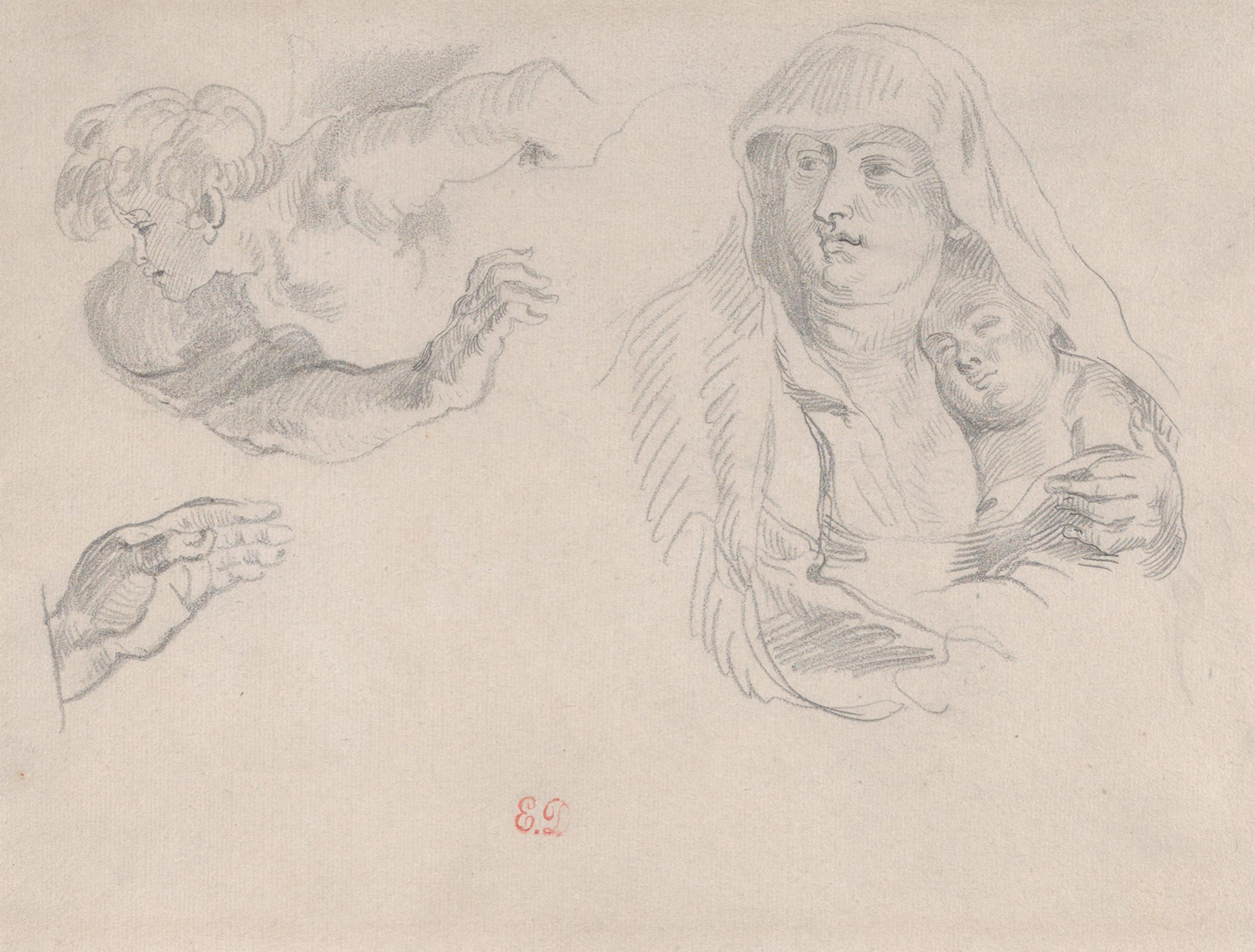
Eugène Delacroix (French, 1798–1863). Studies after Rubens's The Flight into Egypt, ca. 1830. Graphite, 6 1/2 x 8 3/4 in. (16.5 x 22.2 cm). Promised Gift from the Karen B. Cohen Collection of Eugène Delacroix, in honor of Patricia Reddington Harvey
Michael Cirigliano: Delacroix was a prolific copyist, and the "Formation through Drawing" gallery displays a number of his elaborate copies of works by Raphael, Rubens, and Veronese, among other old masters. How did the process of copying help Delacroix to hone his artistic eye?
Ashley Dunn: This gallery shows the variety of manners in which he copied, and that he used copying to different ends. In the case of the Raphael copies, he's quite loyal to the source and appears to be investigating composition. I say on one of the label texts how he most admired in Raphael "perfection of drawing, grace, and composition." So we see where he's looking at how these bodies fit together, but then his more typical manner of copying is selective. In those cases, I think he's taking a greater interest in expression.
A good example here is this copy after Rubens's The Flight into Egypt, where he selected these very small details: the hand of Joseph, this angel looking back over her shoulder, and Mary looking back toward, really, the hand of Joseph. He identified the elements that give meaning to the scene and chose to highlight them in his copy.
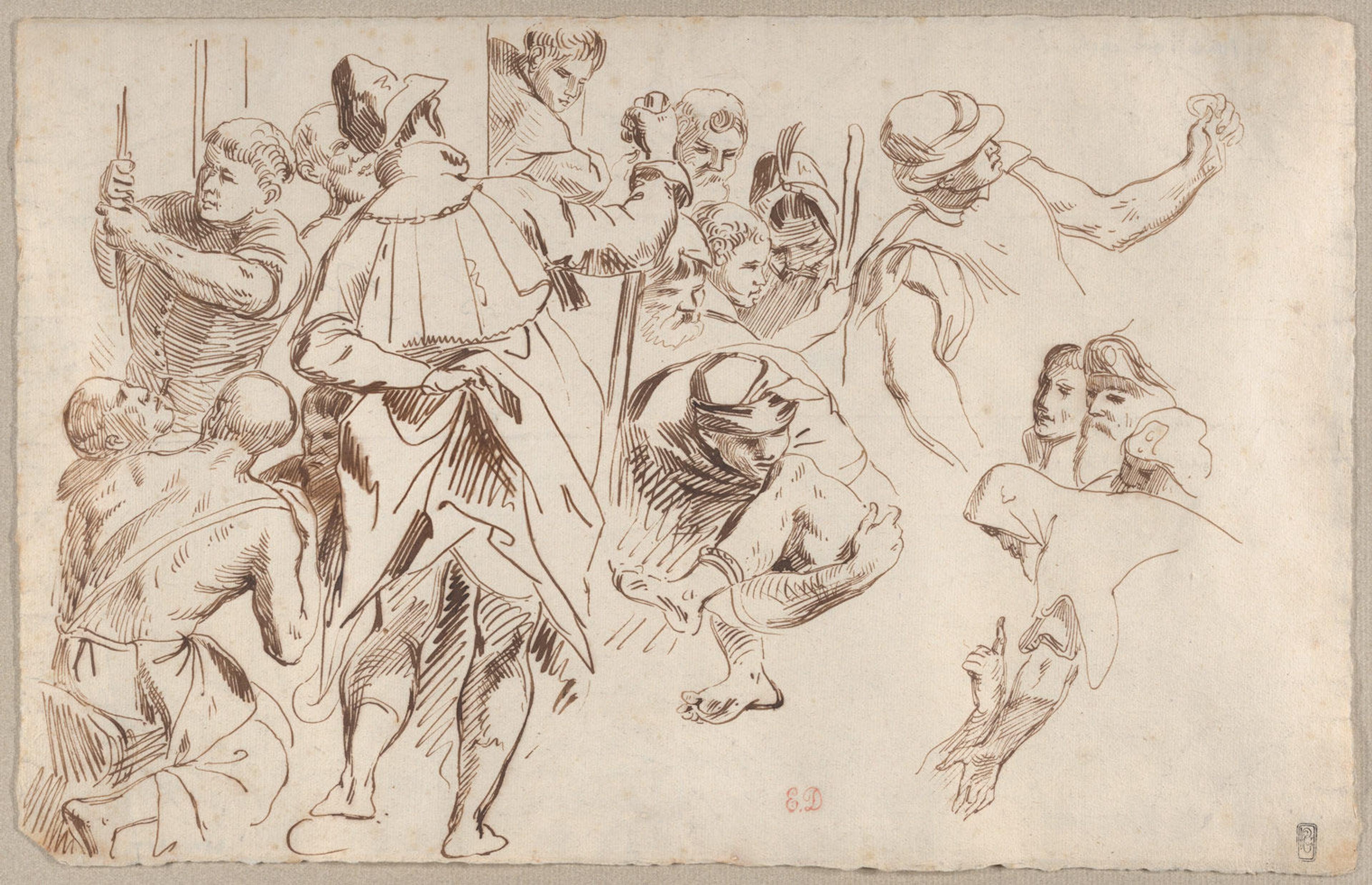
Eugène Delacroix (French, 1798–1863). Figure Studies, after Veronese's The Martyrdom of Saint Sebastian, ca. 1823. Pen and brown ink, 9 x 14 in. (22.9 x 35.6 cm). Promised Gift from the Karen B. Cohen Collection of Eugène Delacroix
Michael Cirigliano: Another interesting example is his copy of The Martyrdom of Saint Sebastian. He's obviously studying Veronese's composition and how best to create a massive crowd scene, but it's almost humorous to see that Saint Sebastian—except for his left forearm and hand and one of his legs—actually isn't present in the composition! [laughter] To see him extracting certain elements from these works and then eliminating others is really interesting to me, that the focal point of the drawing here is not actually what Delacroix is honing in on.
Ashley Dunn: Definitely. Here he's looking at the expression of the crowd reacting to the scene, rather than what we would think of as the central subject.
Michael Cirigliano: I love the wide variety of works on view in the next gallery, "Application of Drawing," all of which have different levels of, for lack of a better term, a "finished" sensibility—some are akin to doodles, as we discussed before, while others are more complete and absolutely worthy of exhibition as artworks in their own right. Delacroix saw the drawing of nature as not the end goal of his work but as a component of a larger artistic process. How do we see him approaching depictions of nature throughout his career?
Ashley Dunn: Certainly it's something that was ingrained in him early on. His teacher, Pierre Narcisse Guérin, advocated for the study of nature over relying solely upon studies of antiquities, as was more often emphasized in academic drawing practice. With Delacroix, we see him attending to nature early on, but we also see almost a crescendo of deepening interest in nature over the course of his career. He escaped Paris by visiting family, often at the Valmont estate in Normandy, which was owned by his cousin. Later on, he rented a property in the forest of Sénart, also not too far from Paris, and eventually purchased a house there.
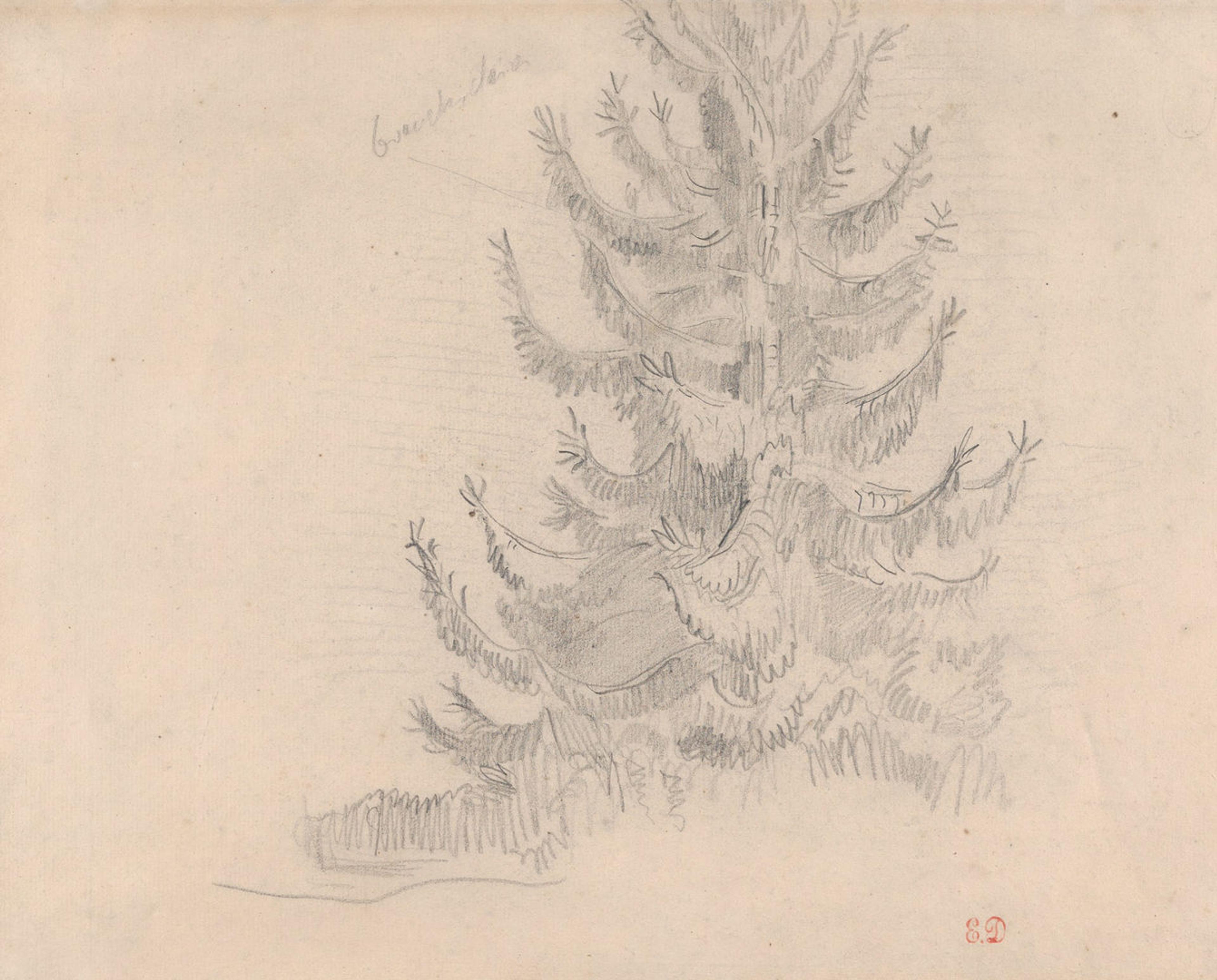
Eugène Delacroix (French, 1798–1863). Fir Tree, 1850s. Graphite, 9 7/8 x 13 in. (25.1 x 33 cm). Promised Gift from the Karen B. Cohen Collection of Eugène Delacroix, in honor of Andrew Bardolf
From the 1850s on, we see his deepening affinity for nature, and it's interesting to me that we see it both in his drawing and in his journal. Something like this fir tree, for example, really has textual equivalents in the journal; Delacroix describes his walks through the landscape, and after coming upon a tree that strikes him, writes almost a portrait of that tree as he might otherwise sketch it.
Michael Cirigliano: He often remarked in his journal how refreshing these walks were, how much inspiration he derived from them. It seems like yet another mechanism where he was finding freedom—or at least investigating ways to approach artistic freedom—and being directly inspired by what he saw.
Ashley Dunn: He finds that in Paris, too, when he goes to the Jardin des Plantes to study the animals there. There's a break in his journal between the early part of his career and 1847, when he picked it up again. Actually, the first journal entry in 1847 is an account of one of his visits to the Jardin des Plantes, and he conveyed this sense of awakening to nature. He went there to sketch the animals, but he found after he left that all of a sudden the trees came into his consciousness in a way they hadn't before. Nature provided a kind of refreshment for him.
Michael Cirigliano: It's interesting to witness that refreshment in these early drawings. I love the term you used before, "crescendo," because by the time we get to the later drawings, we see how all of the work that he did in drawing dozens and dozens of horses and other animals in various stances really worked well, because he's able to give such a sense of action and such a sense of forward motion to the animals when he starts developing them as subject, rather than kind of an exploratory treatment.
Ashley Dunn: Exactly. On the one hand, we have these very carefully studied animals; and then he put them into motion and injected these figures in combat, probably drawing upon Byron as a literary source. He was very adept early on at allowing his study of nature to inject a sense of life into the drawings and paintings for that matter.

Eugène Delacroix (French, 1798–1863). Left: The Agony in the Garden, 1823–24. Brush and brown wash over graphite, 5 1/4 x 7 5/8 in. (13.4 x 19.4 cm). The Metropolitan Museum of Art, New York, Gift from the Karen B. Cohen Collection of Eugène Delacroix, in memory of Jacob Bean, 2013 (2013.1135.4). Right: The Agony in the Garden, ca. 1849. Brush and brown and black wash, sheet: 4 7/16 x 7 5/8 in. (11.3 x 19.4 cm). Promised Gift from the Karen B. Cohen Collection of Eugène Delacroix
Michael Cirigliano: I find it really fascinating that Delacroix would return to the same subject in his drawing, sometimes decades apart from each other. There are two versions of The Agony in the Garden in the exhibition that were created more than twenty years apart—one in the mid-1820s, the other about 1850. What advancements do you feel like he's made in his approach to this scene over that time span?
Ashley Dunn: It's absolutely true that he had a kind of obsession with certain subjects over the course of his career and that he returned to them again and again. One of the more practical ways of explaining this is that by the late 1840s and fifties, there was a great demand for his work on the market, so he returned to some of his earlier pictures that he created for the Salon or for monumental commissions, and reduced them to an easel scale to sell to collectors and dealers.
But he also had a mind that was continually rethinking and revising, so it is more meaningful than that, in terms of the subjects that he chose to revisit. In the case of The Agony in the Garden, this was his first official religious commission, for the Church of Saint-Paul-Saint-Louis in Paris. What is interesting to compare about these two is the fact that he uses brown wash in both cases, which I think is very significant for the meaning of both works—the importance of light in conveying the meaning is so beautifully expressed in the range of tones in the wash. But in terms of an evolution, I think we see a simplification of form, from a multifigural composition centering on Christ accompanied by a group of mourning angels to the same subject portrayed with just the single figure.
Michael Cirigliano: There's such a sparseness and a sense of existential crisis present when Christ is alone in the later drawing. Unlike the first drawing, where he is upright and leaning away from the angels, almost in fear rather than awe, the second one shows him on his hands and knees, looking absolutely defeated. In certain ways, there's a great sense of pity and crisis in the 1849 drawing than what we see in the earlier version here.
Ashley Dunn: Yeah, there's an amazing amount of pathos in the figure.
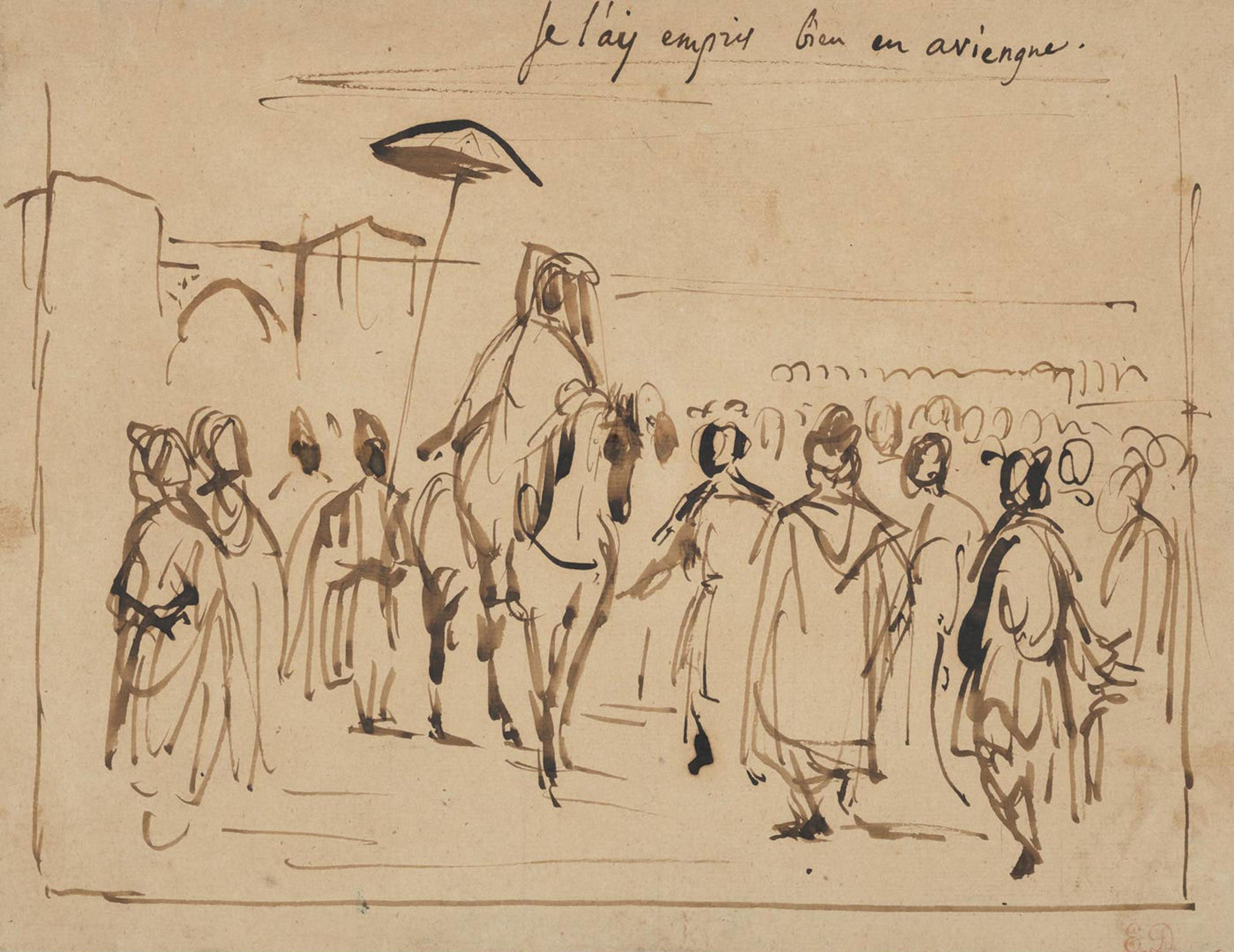
Eugène Delacroix (French, 1798–1863). Study for The Sultan of Morocco and His Entourage, 1832–33. Brush and brown ink, 7 5/8 x 9 15/16 in. (19.4 x 25.2 cm). The Metropolitan Museum of Art, New York, Gift from the Karen B. Cohen Collection of Eugène Delacroix, in honor of Henri Loyrette, 2013 (2013.1135.20).
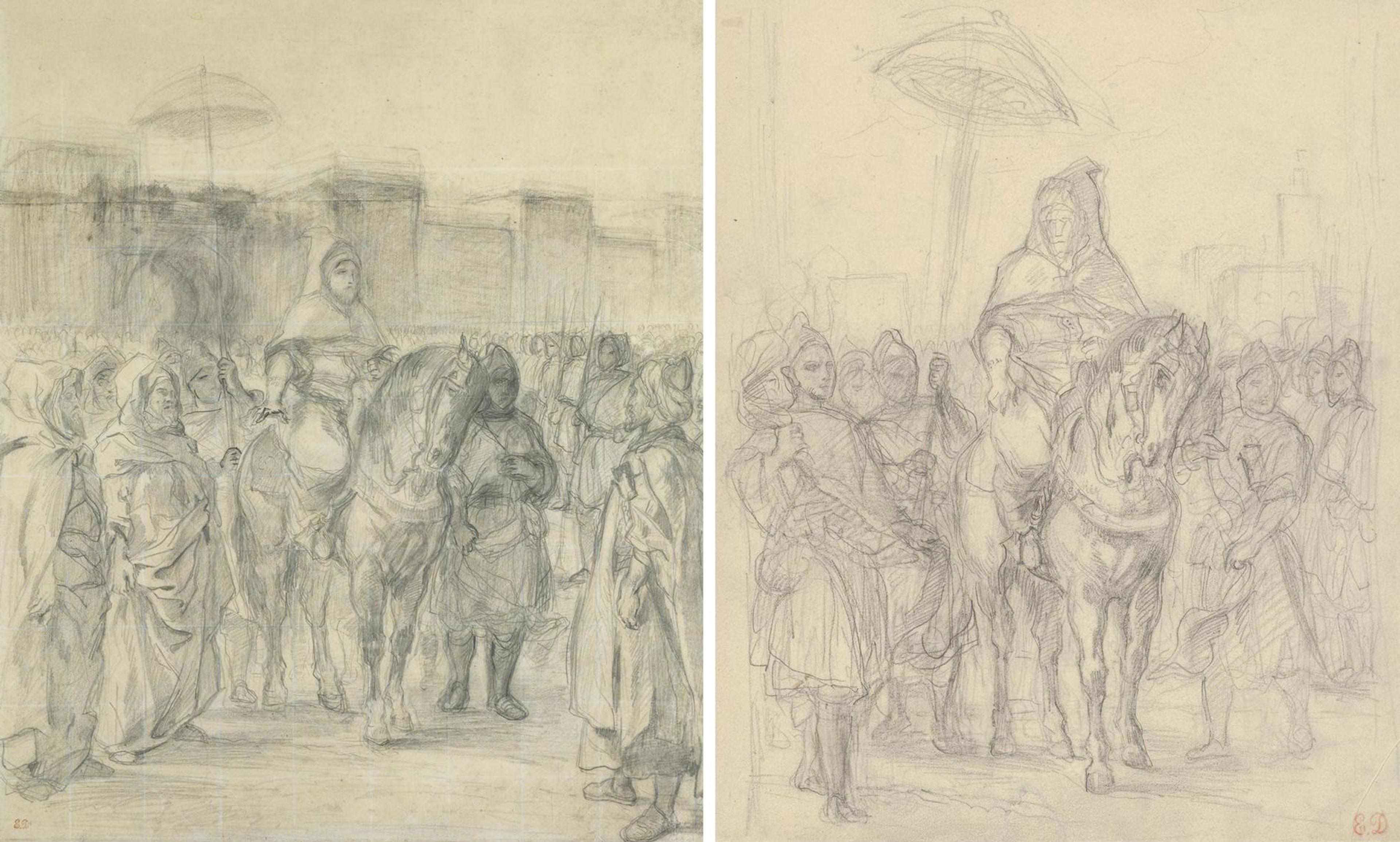
Left: Study for The Sultan of Morocco and His Entourage, 1845. Graphite, squared in white chalk, sheet: 23 1/2 x 19 9/16 in. (59.7 x 49.7 cm). The Metropolitan Museum of Art, New York, Rogers Fund, 1961 (61.202). Right: Study for The Sultan of Morocco and His Entourage, ca. 1855–56. Graphite, 8 1/4 x 10 1/8 in. (20.9 x 25.7 cm). The Metropolitan Museum of Art, New York, Gift from the Karen B. Cohen Collection of Eugène Delacroix, in honor of Henri Loyrette, 2013 (2013.1135.21)
Michael Cirigliano: And then when we arrive at a subject like The Sultan of Morocco and His Entourage, of which there are three different versions here. In this case, there's a very political story behind one of the biggest differences we see between the first drawing, from the early 1830s, and the later ones that he composed in the forties and fifties. What was going on in terms of Delacroix's interest in this subject, his travels to that area of northern Africa, and the politics of the time? There seems to be a boiling pot of different influences at work here.
Ashley Dunn: The second of these drawings has been in The Met collection since the 1960s, so we're very fortunate that with the two additions from the Cohen Collection, we can now present a longer narrative. Delacroix was invited by the Comte de Mornay to accompany him on an ambassadorial mission to Morocco, to meet with the sultan there. The French government's purpose in sending the count was to shore up the support of the sultan in quelling the rebellions that were taking place in Algeria. France had invaded Algeria in 1830, and they were hoping for the sultan's cooperation in maintaining colonial rule in Algeria. In this early version, we have a very summary account of this meeting that Delacroix composed quite soon after it happened, based on the notes he kept during the trip and a schematic drawing in his sketchbook. Here, Delacroix enlarged it slightly and presented all the key players who were there for this meeting.
He had gathered so much material during his trip that it took him years to really digest everything he'd seen in order to compose a significant picture from it. In the case of The Sultan of Morocco, he didn't take it up as a subject for a monumental picture until 1845, at which point the politics, as you said earlier, had really shifted and the French had actually attacked Morocco. The sultan had been supporting the Algerians, so Mornay's mission by that point was no longer seen as a success, and he was left out of the 1845 composition. Instead, Delacroix creates this portrait of a foreign ruler, staged in a very kind of classical way using triangular composition.
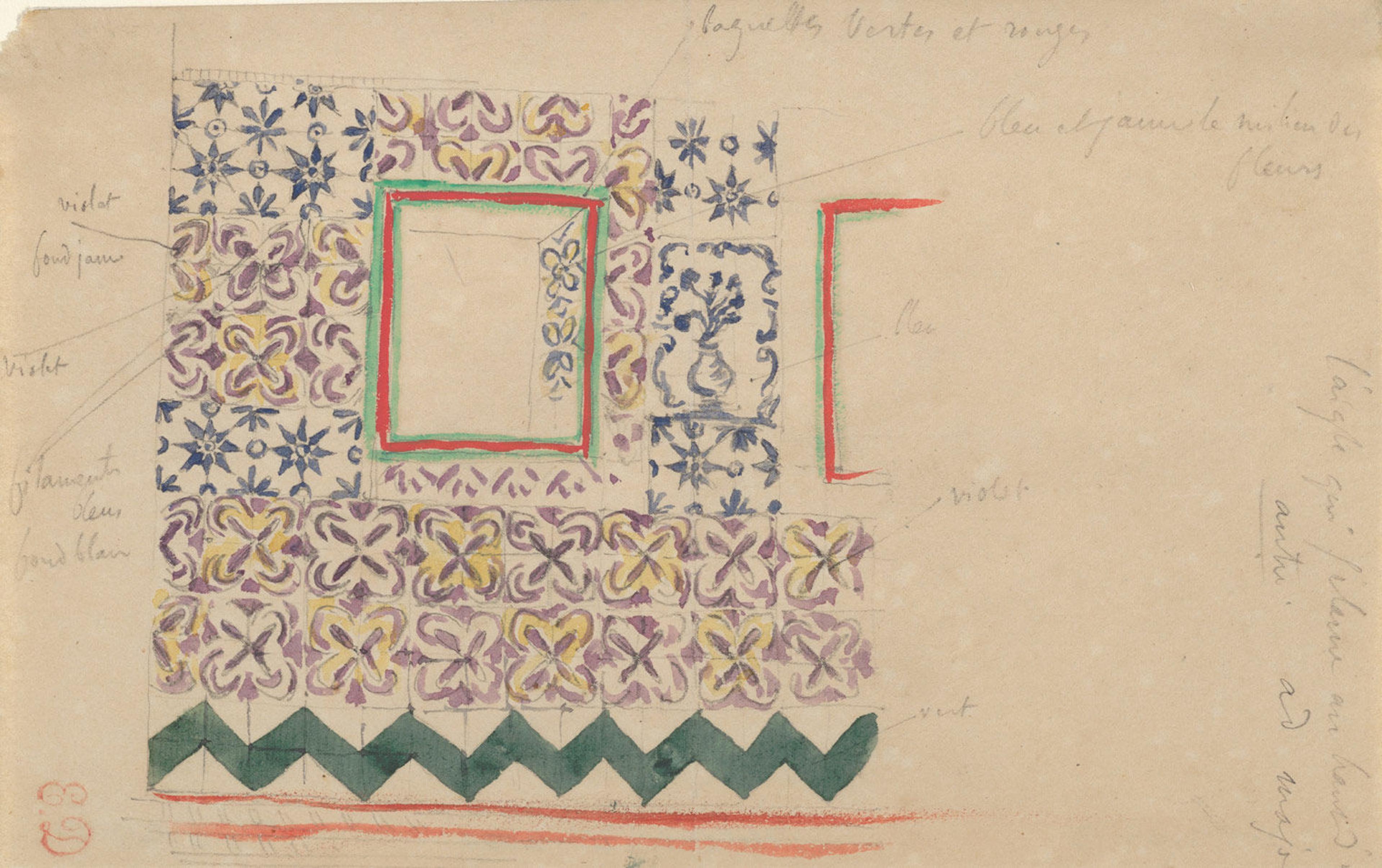
Eugène Delacroix (French, 1798–1863). A Wall Decorated in Spanish Tiles, 1832. Watercolor over graphite, 4 1/2 x 7 1/8 in. (11.4 x 18.1 cm). The Metropolitan Museum of Art, New York, Gift from the Karen B. Cohen Collection of Eugène Delacroix, in honor of Dr. Harvey Wolinsky, 2013 (2013.1135.16)
Michael Cirigliano: I'm in love with the architectural drawings Delacroix composed during his trip to Morocco. This one in particular, A Wall Decorated in Spanish Tiles, is such a window into his process, because there's the initial drawing and the color that he applied later, but there's also writing on the drawing, various notes he made to himself about which colors needed to be applied. What would've been his overall process here? Would he have made the notes for the colors at the same time he made the initial drawing? How much later would he have applied the color? It seems to be a really captivating snapshot of a longer process, rather than simply sketching in person or from memory.
Ashley Dunn: You've put it very well! It is a process that he used throughout his trip—to sketch things very quickly in graphite while onsite, and then to make these notations for himself about color and tone. It's interesting from our perspective, because we think of watercolor today as being the epitome of a portable medium that you take with you to make a drawing outdoors or in front of the motif. But as conservator Marjorie Shelley points out in her essay in the catalogue, at this time watercolor was not as portable as it is today. It was more of an involved process to prepare, and so he probably would have added the color later, after returning to his accommodation. Maybe it would've been days later. I do expect that he would've wanted to do it while it was still fresh in his mind, however.
Michael Cirigliano: Speaking of watercolor, the exhibition's final gallery, "Medium and Invention," displays a number of Delacroix's watercolors, which were the only drawings he exhibited during his lifetime. What drew him to the medium? Especially given the fact that it wasn't portable or easy to use at the time.
Ashley Dunn: Delacroix was initially inspired by his British contemporaries to try it out. He became friends with Richard Parkes Bonington, who was working in Paris at this time, and it was likely Bonington who encouraged Delacroix to try watercolor. In terms of why it was appealing to him, Delacroix had a great preoccupation with color, and so watercolor as a medium allowed him to explore hues, tones, tints, shadows, and reflections, and the different ways that colors interact. He wrote about how watercolor, in comparison to oil paint, appealed to him for its luminosity and delicacy, but he was also trying different ways of manipulating the medium—layering, using a reductive technique. He was definitely still exploring when he was using watercolor.
Left: Eugène Delacroix (French, 1798–1863). Goetz von Berlichingen Being Dressed in Armor by His Page George, 1826–27. Watercolor and bodycolor with gum arabic on wove paper, 8 3/8 x 5 5/8 in. (21.3 x 14.3 cm). The Metropolitan Museum of Art, New York, Gift from the Karen B. Cohen Collection of Eugène Delacroix, in honor of Thomas P. Campbell, 2014 (2014.732.2)
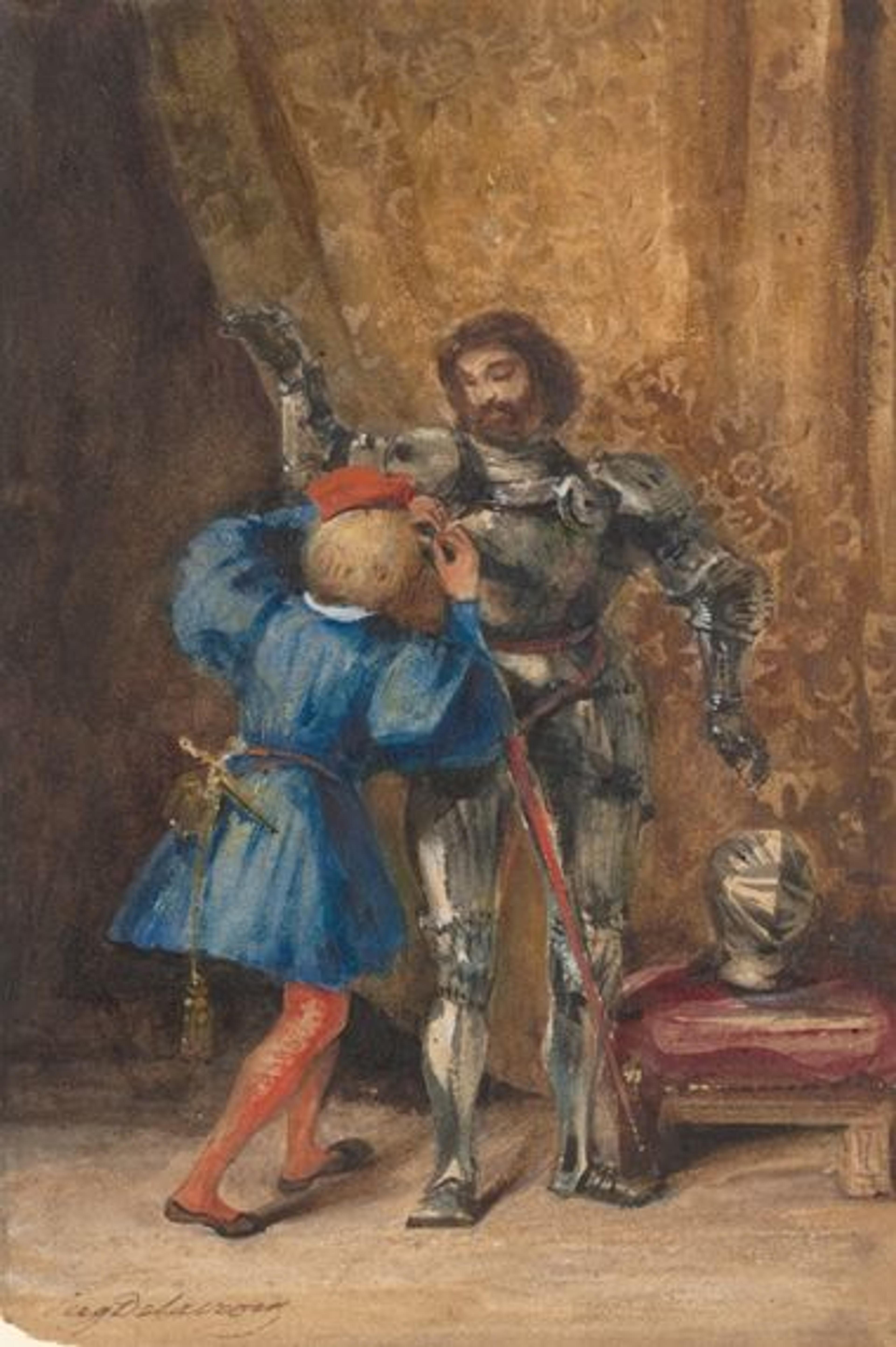
Michael Cirigliano: Goetz von Berlichingen Being Dressed in Armor by His Page George is a great example of that. There are so many different textures at hand: the tapestry in the background has beautiful detail work; there's a shimmer to one side of the right leg of the armor; there's a soft quality to the page's tunic. Especially when we compare this very "finished"-looking work to the sheets of studies installed on the same wall, it really seems like he's plotting out different color combinations and playing with different hues. It must have been so exploratory, and probably an easier way to explore than oil painting would've been at the time.
Ashley Dunn: I think so. It is great to see here how he is testing his brush and blotting, and to see that juxtaposed with the monochrome gray wash drawings, which show the variety of expression that he could achieve with just this simple brush and one tone. The fact that he conveyed all of these different characters and their expressions through that medium is remarkable.

Eugène Delacroix (French, 1798–1863). Duel between Faust and Valentine (left) and Mephistopheles and Faust Fleeing after the Duel (right), from Faust, 1828. Lithographs on chine collé, 15 1/2 x 11 13/16 x 1 3/16 in. (39.4 x 30 x 3 cm). Promised Gift from the Karen B. Cohen Collection of Eugène Delacroix
Michael Cirigliano: Finally, as we can see from all of the illustration work in this gallery, Delacroix had incredible taste in literature! Was it common for an artist at the time to work so much with illustration, or was this something that particularly piqued his interest, these works by Shakespeare and Goethe? There are so many of them in the Cohen Collection, and I'm interested to know the backstory.
Ashley Dunn: He did always have a great interest in literature. It served as an invaluable source for his imagination. Before he committed to becoming a painter, he weighed the merits of writing versus painting. And he continued throughout his career to have literary ambitions; he published articles and he took his journal writing very seriously. He even revised some of his own earlier journal entries!
The literary was always important to him, but the reason that he first started in illustration was actually a commission. Charles Mott, a publisher in Paris, commissioned Delacroix to make illustrations for the first French translation of Faust. What's interesting here is the tension between the text and the images: Delacroix was actually resistant to the idea of the illustrations being published in a volume with the text. He would've much preferred, as he did later with Hamlet, to have them published as just a group of plates, independent of the text. In this case, though, he didn't really have a choice, and so, reluctantly, they were published with the text. I find that tension fascinating—that he loved literature so much, but yet there seems to be this sense of competition at hand.
Michael Cirigliano: As if he didn't want anything distracting from the work he had done.
Ashley Dunn: This work is also important in the history of illustration because it's the first significant use of lithography to illustrate contemporary literature. Lithography was still a relatively new medium at the time. As we see with the satirical lithographs also on view in this gallery, he started working in lithography very early on. Although he abandoned this kind of satirical practice almost as soon as he was successful, he did continue with lithography throughout his career—another layer to his relationship with works on paper.
Related Content
Devotion to Drawing: The Karen B. Cohen Collection of Eugène Delacroix is on view at The Met Fifth Avenue through November 12, 2018.
View a selection of works presented in the exhibition and take a walkthrough of the galleries.
The exhibition catalogue, by Ashley E. Dunn with contributions by Colta Ives and Marjorie Shelley, is available for purchase at The Met Store.
A comprehensive retrospective of the artist's work, Delacroix, is on view at The Met Fifth Avenue through January 6, 2019.
Michael Cirigliano II
Michael Cirigliano II is the managing editor in the Digital Department.